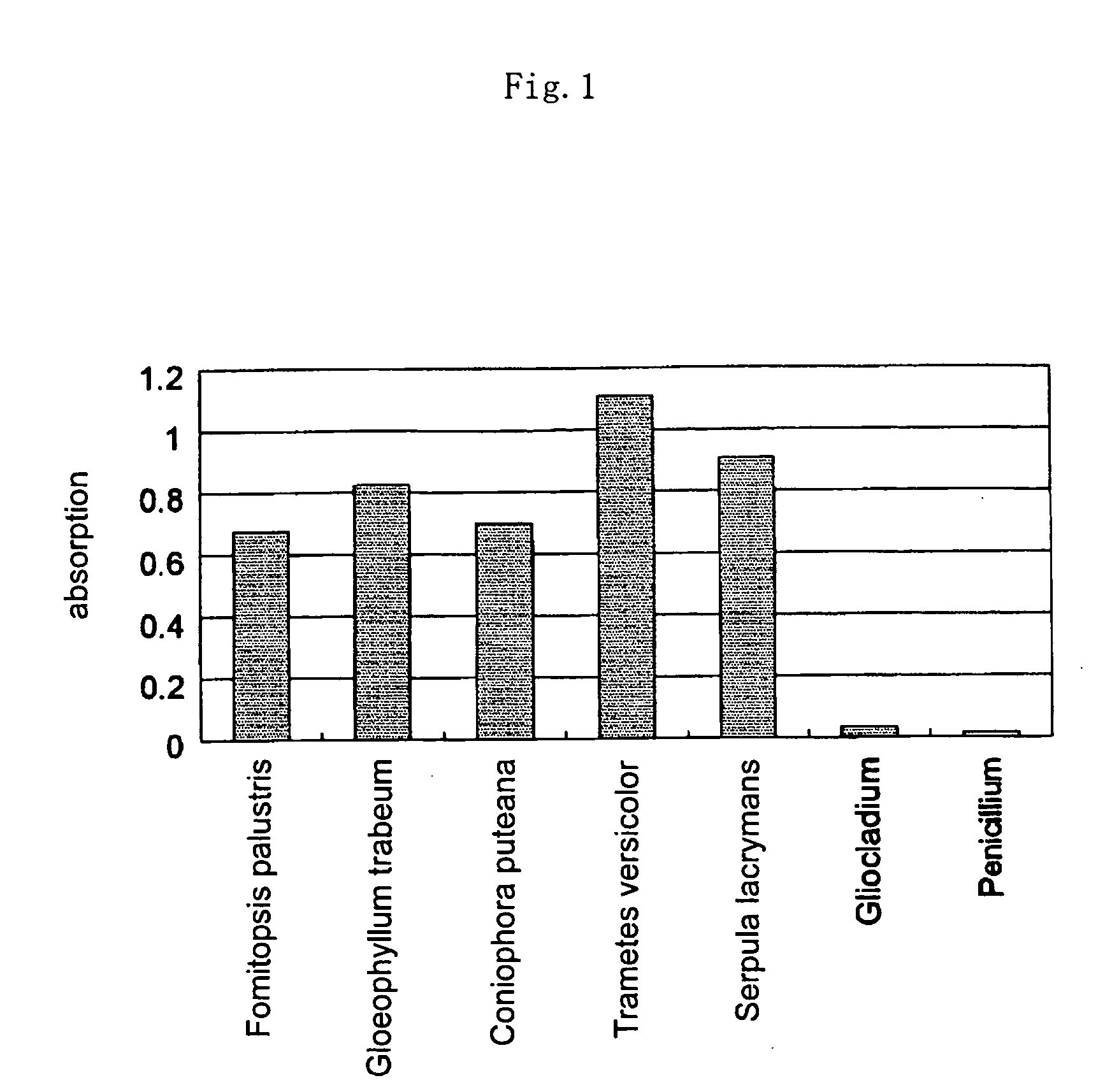Method of diagnosing wood decay and decay diagnostic agent
- Summary
- Abstract
- Description
- Claims
- Application Information
AI Technical Summary
Benefits of technology
Problems solved by technology
Method used
Image
Examples
example 1
Preparation of Antibody
(1) Preparation of Antigen
[0065] 50 ml of liquid medium (pH 5.5) which contains 1% cellobiose, 0.2% NH4NO3, 0.2% KH2PO4, 0.05% MgSO4.7H2O, 0.01% CaCl2.2H2O, 0.57 ppm H3BO4, 0.036 ppm MnCl2.4H2O, 0.31 ppm ZnSO4.7H2O, 0.039 ppm CuSO4.5H2O, 0.018 ppm (NH4)6Mo7O24.4H2O, 0.015 ppm FeSO4.7H2O, 1 ppm thiamine hydrochloride, 0.5% peptone and 0.05% yeast extract was added into a 500 ml flask for culture, the flask was plugged with cotton and sterilized in an autoclave at 121° C. for 30 minutes.
[0066]Fomitopsis palustris (Berk. Et Curt.) Gilbn. & Ryv. FFPRI 0507 was inoculated in this medium, statically cultured at 27° C. for 2 weeks and the obtained cultured solution was filtered by a glass filter, to thereby obtain cultured filtrate. The cultured filtrate was filtered by an ultrafilter membrane (Ultrafree-15, Biomax 100, a membrane-attached unit by Millipore Corporation), to thereby obtain a fraction having a molecular weight of 100,000 or less. This fraction was ...
example 2
Diagnosis by Using ELISA Method
(1) Preparation of Decayed Wood Chips and Extract from the Decayed Wood Chips
[0068] As culture substrates, 10 pieces of cedar splint wood and 20 ml of pure water were placed in a 500 ml-volume Erlenmeyer flask, and after plugged with cotton, the medium was sterilized in an autoclave at 121° C. for 30 minutes.
[0069] In this way, 7 of such an Erlenmeyer flask were prepared and strains of 7 kinds of fungi, Fomitopsis palustris, Gloeophyllum trabeum, Coniophora puteana, Serpula lacrymans, Trametes versicolor, which are wood-destroying fungi, Penicillium funiculosum (which is used in JIS fungus resistance test) which is a wood surface contaminant fungus and Gliocladium virens Miller (which is used in JIS fungus resistance test, former name: Trichoderma viride) were respectively inoculated, and kept at 24° C. for 4 weeks.
[0070] After 4 weeks, from thus decayed wood pieces, small chip-like wood samples were taken our by using a manual drill. To the sampl...
example 3
Determination of Wood Decay by Dot-Blot Method
[0076] The wood extract was prepared in the same manner as in Example 2, and 10 μl of the extract from each of the test subject wood samples and a control were spotted to a nitrocellulose membrane (0.451 μl of nitrocellulose membrane, product of BIO-RAD Laboratories, Inc., hereinafter simply abbreviated to as “membrane”). This membrane was dried for 10 minutes. The membrane was washed twice with PBS which contained 0.05% Tween 20 (hereinafter, this operation is referred to as “washing”). Then, the membrane was immersed in a blocking buffer liquid (PBS which contained 1% BSA and 0.05% Tween 20), incubated at 37° C. for 10 minutes and the membrane was subjected to washing.
[0077] The antibody solution obtained in (2) of Example 1 was diluted with PBS, the membrane was immersed in the solution, and the membrane was incubated at 37° C. for 10 minutes. After washing the membrane, the membrane was immersed in alkaline phosphatase-conjugated g...
PUM
| Property | Measurement | Unit |
|---|---|---|
| Temperature | aaaaa | aaaaa |
| Decay rate | aaaaa | aaaaa |
| Molecular weight | aaaaa | aaaaa |
Abstract
Description
Claims
Application Information
 Login to View More
Login to View More - R&D
- Intellectual Property
- Life Sciences
- Materials
- Tech Scout
- Unparalleled Data Quality
- Higher Quality Content
- 60% Fewer Hallucinations
Browse by: Latest US Patents, China's latest patents, Technical Efficacy Thesaurus, Application Domain, Technology Topic, Popular Technical Reports.
© 2025 PatSnap. All rights reserved.Legal|Privacy policy|Modern Slavery Act Transparency Statement|Sitemap|About US| Contact US: help@patsnap.com

